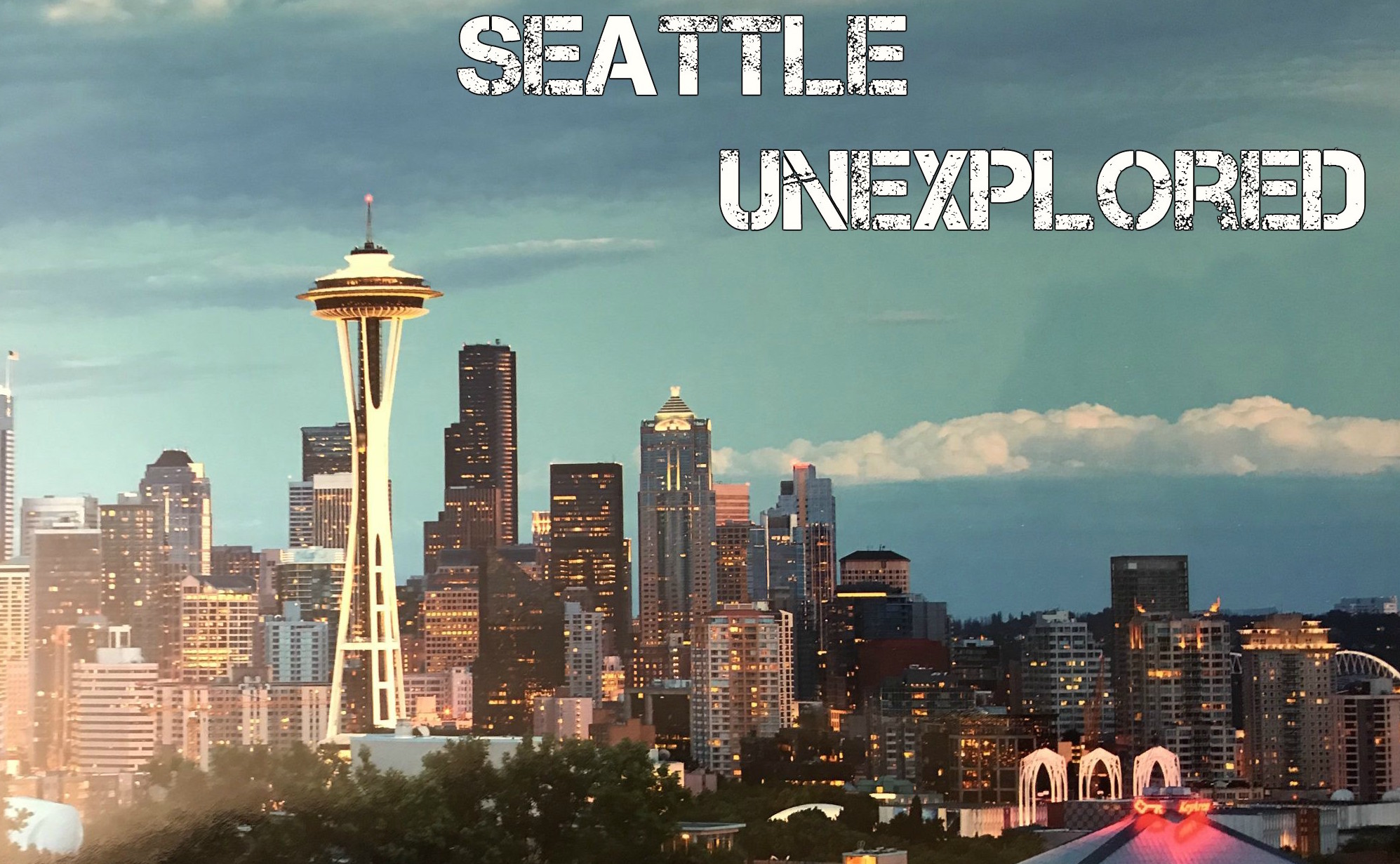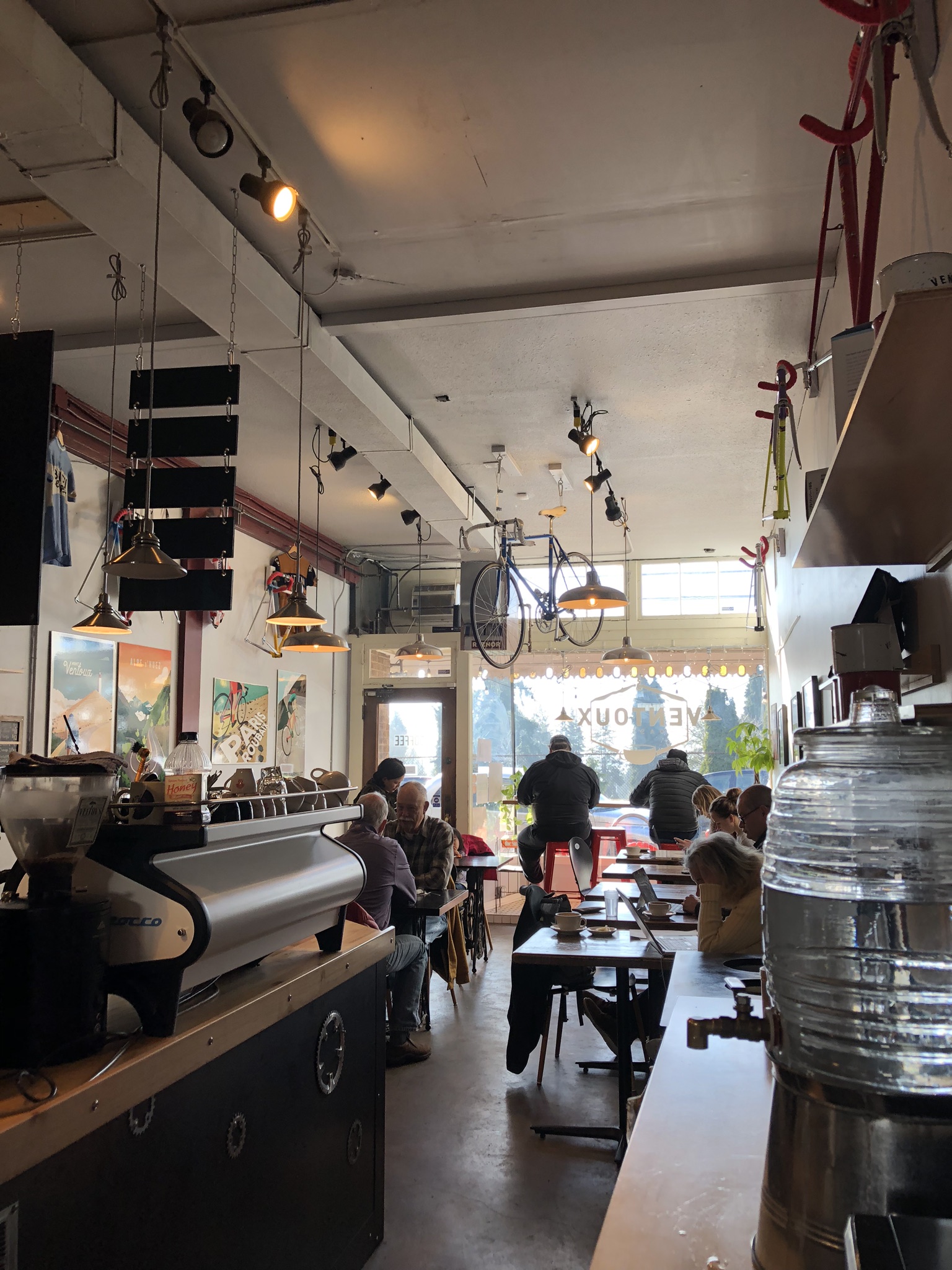this is a page for
Monthly Archives: March 2020
The Relationship Between Coffee and Cycling – Seattle

For some reason there is some type of correlation/relationship between coffee and cycling as evidenced by the multiple cycle shops that serve coffee or bicycle themed coffee shops around Seattle, such as Peloton Cafe, Metier Seattle Cafe, Ventoux Roasters, Rapha Seattle, Good Weather Bicycle & Cafe, Pim Coffee. Even Caffe Umbria in Ballard has a cycling jersey hanging. And any longtime Seattleite knows that if you ever walk by Monorail Espresso in downtown, you’ll see a bunch of bike messengers hanging out there.
Bicycling Magazine named Seattle the Best Bike City in the US. And we all know Seattle is known for it’s coffee scene, so in a way it makes sense that we have so many cycling themed coffee shops.

Source: Yelp
It got us curious about the relationship between coffee and cycling, so we’d thought we’d research it. What peaked our curiosity was that you don’t hear about marathon runners, basketball players, football players, tennis players or any other athletes who seem to need a punch of energy and a high level of endurance, drinking coffee. Let’s delve in, shall we?
It appears that cyclists have turned to coffee to help with performance for quite some time. In fact ,the WADA(World Anti-Doping Agency) monitored and set a limit of caffeine below 12 microgrammes per millitre of urine, which is 8 shots of espresso. This limit was done away with in 2004.

Source: Yelp
Here are some articles we found that explain the love affair between cyclists and coffee and some of the reasons behind it:
Why Do Cyclists Drink So Much Coffee? By Jiří Kaloč
It affects how you pace yourself-Scientific consensus has swung towards a theory describing how caffeine effects pace regulation during exercise. The science of the brain and exercise performance is still in its early years, so we should still take this with a grain of salt, but it suggests caffeine can lower an athlete’s perception of effort, allowing them to maintain a higher level of output. This means that under the effects of caffeine we allow ourselves to go harder than we otherwise would.

Source: Yelp
Coffee And Competitive Cycling: A Cohesive Bond by MACKENZIE CHAMPLIN
Cyclists, both amateurs and professionals, see coffee as part of their routine. The caffeine elevates the heart rate, expedites blood to muscles, and makes sustained effort less fatiguing. In addition to the physical effects, the mid-ride/post-ride/every-opportunity-possible cafe stop is a ritual among cyclists, who use it as a social destination.
For Daniel Holloway, the two-time defending USA Amateur Criterium Champion, whose year is spent on the road, coffee culture is a nice constant. “When we race as a team, we’re always going to coffee shops wherever we’re at, it’s a ritual. It brings some kind of normalcy to the program that you miss when you’re traveling all over the country. You know the coffee shop is going to be more or less the same wherever you go—the coffee is going to be a little different, the style of the shop is going to be a little different, but that whole atmosphere is very similar. Coast to coast, you know you can sit at a coffee shop and shoot the shit with your friends.”

Source: Yelp
Cycling And Coffee: A Stimulating Study
Coffee and cycling have gone hand in hand together for decades with Italian espresso machine manufacturer Faema sponsoring a pro cycling team all the way back in the 1960s. Caffeine is one of the best performing enhancing drugs for cyclists and studies have shown that low doses of caffeine (~200mg) can positively affect endurance, alertness, and overall cognitive performance during activity.
Drinking coffee after a ride has also been found to improve recovery and glycogen levels also.
Drinking coffee also adds a social experience that brings the entire cycling community together. While the SHIMANO BIKE NYC was open, we had cyclists from all over the city come in to enjoy a nice cup of coffee but also to share in the experience with one another and learn about each cyclist’s story.

Source: Yelp
6 Truths about Coffee and Caffeine-HOW CAFFEINE CAN IMPROVE YOUR RIDE
Caffeine crowds out a calming brain chemical called adenosine,” he says. You become more alert, you react faster, and you don’t feel like you’re working as hard, all of which add up to training or competing at a higher intensity for a longer period of time and being more agile in a pack.
It Will Not Dehydrate You=”In reasonable doses, caffeine alone won’t lead to more bathroom breaks during a ride or a greater risk of dehydration,” says Mindy Millard-Stafford, PhD, former president of the American College of Sports Medicine. The upshot, she says, is that regardless of whether you supplement with caffeine, you don’t need additional fluid to avoid performance-sapping dehydration during a ride. The long-held belief that caffeine can muck with your body’s ability to regulate heat during exercise in hot weather has also been muted by science.
Diy Post-Ride Perk-Australian researchers found that when cyclists refueled with carbohydrates and caffeine after a ride, they accumulated 66 percent more muscle glycogen (the main fuel for working muscles) than when they ate only carbs. This DIY bar provides an ideal combination of the two.

We found that the close relationship between coffee and cycling really does make sense. I was always under the impression that coffee due to it’s caffeine, dehydrated you. I also didn’t realize how prevalent coffee culture was in the cycling world. Doing this research and understanding how bicycle-friendly Seattle is, explains the number of cycling + coffee places there are around Seattle.
Related:
Paju – Queen Anne
Recommended by: We were raving about Revel and their brand new location to some friends. They had just tried a new Korean inspired restaurant in Queen Anne that they claim had some similarities to Revel called, Paju.

Description on the Paju’s Google page: Snug, simple restaurant offering contemporary, inventive takes on traditional Korean cuisine.
Neighborhood/Type: Queen Anne
Address:11 Mercer St, Seattle, WA 98109
What we ate/drank: Paju Fried Rice – Kimchi, bacon, squid ink, smoked quail egg. Yellowtail(Mul Hwe) – Fennel-Cucumber Gazpacho, Gochujang Granita. Mushroom – parmesan cheese, white kimchi, truffle aioli. Rib-eye Steak Bulgogi w/truffle flavor-crispy quinoa scallion, enoki mushroom. Blue Moon Beer.

Comments: Three of our favorite Seattle restaurants fall into the Korean fusion genre – Chan, Joule and Revel. Even Watson’s Counter, one of our favorite breakfast places, can sorta be put in this category. So when we found out another such restaurant had opened to rave reviews and long waits, we had to see for ourselves.
Paju opened in August of 2019 in lower Queen Anne near the Seattle Center and quickly garnered a following that has kept the small industrial space packed. Paju doesn’t take reservations, so when we went on a Friday evening after getting the kids situated with the babysitter, the wait was already an hour long.

We put our cell phone# on the waitlist and headed next door to good ole T.S. McHughs for drinks. We mentioned to our bartender that we were just having drinks while we waited for our seats at Paju. He said he’d hadn’t had a chance to eat at Paju but he was happy to hear that it was doing well. He lamented the demise of the previous business in the location, a nondescript sushi joint.

About an hour later, we received a call from Paju asking us if we could arrive within 5 minutes. We settled our tab at T.S. McHughs and walked over. You could still feel the remnants of that nondescript sushi joint, a very simple rectangular layout with what appears to be a former take-out counter in the back. It’s a bit dim with Edison lights and votive candles providing the lighting. The vibe is industrial and in the way of decor, it’s pretty sparse. No need to fancy up the place. Let the food do the talking. In total Paju probably seats around 40 people max.
The two co-owners have quite the pedigree, having met while working at an New York City, 2 Michelin Star, Korean restaurant. There are a total of only 11 dishes that are served at Paju, but there is a wide variety and should be something for everybody in your party. The dishes are meant to be shared and eaten family styles, so we ordered 4 dishes:
All the dishes have a few things in common. These are traditional Korean dishes with a twist. Like quinoa and truffle with bulgogi, gochujang granita and smoked quail and squid ink with kimchi and rice. Also, none of the dishes are heavy on sauces that overpower. The combination of all the flavors in each dish is very subtle, but works extremely well together.
Our first dish and the one we were most underwhelmed by was the Mul Hwe(Yellowtail). It was sort of like a ceviche. The dish was fine as a starter and the gochujang granita was innovative, but the portion was small for the price or maybe the presentation of the yellowtail spread on the outside of a large bowl just made it seem small.

Beoseot(Mushroom) is a mountain range of seasonal mushrooms with white kimchi and parmesan cheese acting as the snowy peaks. The truffle aioli adds some richness that complements the parmesan. We really enjoyed this one.

The rib-eye steak bulgogi with crispy quinoa, scallion and enoki mushrooms was a beautifully presented dish. We decided to get the optional truffle flavor. We were skeptical of the pairing of truffle and bulgogi, but it really works. Who would have guessed? We also enjoyed unusual addition of enoki mushrooms and quinoa to the dish. We really appreciated the creativity of this one.

Saving the best for last. The Paju Fried Rice contains bacon, kimchi, rice immersed in squid ink with rice with a smoked quail egg yolk in the middle. So many different textures -gooey egg yolk, crunchy kimchi, sticky rice. So many different flavors – smokey, sweet, savory, but none overpowering the others. Such a distinctive dish both visually and taste-wise. You won’t find anything like this in Seattle. This is the dish we’ll get over and over on return visits. I’d love it if they could add more quail eggs. The egg is only able to be mixed with a small percentage of the rice. Definitely, an early contender for top 2020 Dishes of the Year.

The service was attentive and friendly and when my wife mentioned we were there for my birthday, they comped my beer!
Not every dish was a home run, but we really appreciate the updated interpretation on these Korean dishes. When chefs are pushing the envelope creatively and continually experimenting there are bound to be misses, but when a dish hits, the payoff is big. They’ll be dishes so unique that patrons will want to come back over and over to see what new inventive dishes have been created.
Paju is the perfect spot for a dinner prior to going to the Seattle Rep or any other event at the Seattle Center. It will most likely be a Seattle hot spot for sometime if we had to guess.
Ratings:
Atmosphere: 4.25
Service: 5.00
Food/Drinks: 4.60
Bang for the Buck: 4.50
Overall: 4.60
Locals Only Factor: “Locals Only” grading-We’ll assign a grading as to how “local” a place is.
-
- Well known or Touristy. Most locals don’t go there unless they have business dinners or visitors in town.
- Most locals know about it
- Locals “in the know” know about it
- Only those who live close by know about it.
- You’re in on the secret. Don’t tell anybody!
Servers recommendations to visit in the future:
Related Articles:


